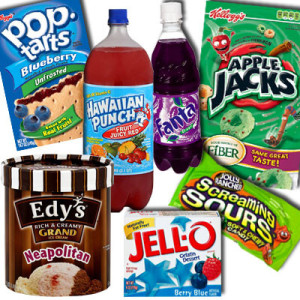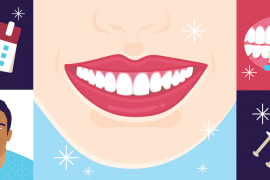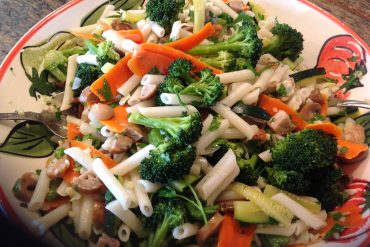Food dyes offer no nutritional benefits to our food. It is purely cosmetic, to make otherwise bland, grey or beige foods seem more appealing. Due to the toxicological considerations related to food dyes, as well as their behavioral effects and hypersensitivity reactions, conventional food dyes should not be considered safe. Foods with artificial coloring should be clearly labeled on the front of the package. Although there are numerous food dyes used by manufacturers, three dyes, Red #40-Allura Red, Yellow #5 -Tatrazine and Yellow #6- Sunset Yellow compose 90% of all the dyes used. An area of concern is that lab testing is done on individual colors, not on numerous colors combined in a product. Processed foods usually contain more than one food color.
Consider This
Due to numerous bans on food coloring in other countries, many manufacturers sell the same products in other countries without toxic food colorings. Kellogg’s, Kraft, Mars, McDonalds and Nestle sell their products in the EU (European Union) without artificial food colorings. For example in the U.S. Kellogg’s Nutri Grain Blueberry cereal bars use Red #40 and Blue #1. In the U.K. the same product is manufactured using Beetroot Red, Annatto and Paprika extract.
Purpose of Food Coloring
Food coloring has been used to enhance the aesthetics of foods for thousands of years. Throughout history, herbs and spices have been added to foods to give them additional flavor, color and make them more appealing. Nature’s rainbow coloring of foods is a feast for the eyes, and the herbs and spices offer nutritional value to the foods being consumed. But man’s synthetic rainbow is another story. Today most artificial colors are made from coal. Coal tar is used in other products such as sealcoat for preserving the shine on industrial floors and head lice shampoo.
The Center for Science in the Public Interest (CSPI)
According to CSPI Executive Director Michael Jacobsen “These synthetic chemicals do absolutely nothing to improve the nutritional quality or safety of foods, but trigger behavior problems in children and, possibly, cancer in anybody.” He goes on to say “The Food and Drug Administration should ban dyes, which would force industry to color foods with real food ingredients, not toxic petrochemicals.”
In their 58-page report, “Food Dyes: A Rainbow of Risks,” CSPI revealed that nine of the food dyes currently approved for use in the United States are linked to health issues ranging from cancer and hyperactivity to allergy-like reactions — and these results were from studies conducted by the chemical industry itself. Click here to read the report.
Food Coloring, Where They’re Found and the Health Risk
Blue #1-Brilliant Blue
The FDA approved Blue #1 for general use in food and ingested drugs in 1969. In 1982 it was later approved for externally applied drugs and general use in cosmetics, excluding the area of the eye. (1)
Most of the studies performed were sponsored by the industry, and no evidence of carcinogens was discovered. Other studies raise some red flags. An abstract review by IARC states that male mice had significant increased incidence of kidney tumors. In vitro tests also suggested the potential for neurotoxicity. (1)
Where it’s found: Baked goods, beverages, candies, cereals, ice creams, processed peas, dry soup packets, food coloring bottles, popsicles, sweets, soaps, shampoos, mouthwash, and medications.
What’s the risk: It can induce an allergic response in individuals with pre-existing moderate asthma. The dye can cause hypersensitivity reactions. (1) Blue #1 has been banned in Austria, Belgium, Denmark, France, Germany, Italy, Spain, Sweden and Switzerland. It has been certified as food safe in the EU and is legal in most countries. (2)
Blue #2 Indigo Carmine
In 1983 Blue #2 was approved for permanent listing in foods and ingested drugs. At this time the Public Citizen Health Research Group (HRG) filed an objection on the grounds that the increase in brain tumors in rats fed Blue 2 was statistically significant. The group argued that the decision to list Blue 2 permanently violated both the Delaney Clause (which bars cancer causing food and color additives) and the general safety clause since the dye had not been proven safe (FDA 1988). In a statement to the HRG in 1982, Dr. William Lijinsky, a cancer specialist at the National Cancer Institute’s Frederick Cancer Research Center, wrote,…”the incidence of these (brain) tumors in the high dose group versus the controls is highly significant…In my own laboratory this would be considered prima facie evidence of carcinogenicity of a treatment. This is especially so because this tumor is so rare, and my conclusion is that Blue 2 is a carcinogen, and should be regulated accordingly.”
Where it’s found: Beverages, candies, pet foods and drugs.
What’s the risk: Causes a statistically significant incidence of tumors, particularly brain gliomas, in male rats. (1) Indigo carmine is harmful to the respiratory tract if inhaled. It is also an irritant to the skin and eyes. Proper laboratory cautions (lab coat, gloves, and goggles) are advised. In surgery, intravenous indigo carmine is used to highlight the urinary tract. The dye is filtered rapidly by the kidneys from the blood, and colors the urine blue. This enables structures of the urinary tract to be seen in the surgical field, and demonstrate if there is a leak. However, the dye can cause a potentially dangerous increase in blood pressure in some cases. (3)
Citrus Red #2
This color was banned in 1990 for topical use, but can still be used for foods and beverages. According to innvista.com, oranges look the most appealing to consumers when they are a deep, vibrant orange color; but, on the tree, a mature orange is usually green-skinned. It will turn orange only if the cold temperature destroys the green chlorophyll pigments, allowing the yellow carotenoids underneath to show through. Green oranges will also change color if they are exposed to ethylene gas and dyed with Citrus #2.
Where it’s found: Maraschino cherries, grenadine, and the dye is used on the skins of Florida oranges.
What’s the risk: It’s toxic to rodents at modest levels and caused tumors of the urinary bladder and possibly other organs.
Green #3 Fast Green
Where it’s found: Bakery mixes, canned green peas, cosmetics, desserts, drugs, personal care products, fish, jellies, sauces and processed vegetables. (4) It is poorly absorbed by the intestines
What’s the risk: This food dye is prohibited in EU and other countries. Caused significant increases in bladder and testes tumors in male rats. (1)
Red #3 (Erythrosine)
Used as a dye in foods, drugs and cosmetics since its approval by the US Department of Agriculture in 1907.
Where it’s found: Sausage casings, oral medication, maraschino cherries, printing inks, popsicles, and baked goods, candies, widely used in cake decorating gels and for biological stain.
What’s the risk: In the 1990’s the U.S. FDA issued a partial ban on erythrosine, citing research that high doses have been found to cause cancer in rats. (5) Recognized in 1990 by the FDA as a thyroid carcinogen in animals and is banned in cosmetics and externally applied drugs. (1)
Red #40 (Allura Red)
This is the most-widely used and consumed dye.
Where it’s found: Beverages, bakery goods, dessert powders, candies, cereals, foods, drugs, and cosmetics.
What’s the risk: On June 30, 2010, the Center for the Science in Public Interest (CSPI) called for the FDA to ban Red #40. (6) It may accelerate the appearance of immune system tumors in mice. It also causes hypersensitivity (allergy-like) reactions in some consumers and might trigger hyperactivity in children. It is banned in Belgium, Denmark, France and Switzerland. In Europe Allura Red is not recommended for consumption by children.
Yellow #5 (Tartrazine)
Is a synthetic yellow azo dye. Of all the azo dyes tartazine causes the most allergic and intolerant reactions, particularly among those with aspirin allergies and asthma. (7) Symptoms can appear anywhere from minutes to 14 hours.
Where it’s found: Ice cream, candies, cotton candy, chewing gum, instant puddings, gelatins, pet foods, numerous bakery goods, beverages, dessert powders, candies, cereals, gelatin desserts, and many other foods, as well as pharmaceuticals , bar soaps, tanning lotions and cosmetics.
What’s the risk: Yellow 5 can cause severe hypersensitivity reactions and might trigger hyperactivity and other behavioral effects in children. Consumed over a prolonged period of time, Tartazine inflamed the stomach linings of rats. (8) It also caused adverse affects in vital organs such as the liver and kidneys of rats, regardless of dose size. Tartrazine was found to adversely affect and alter biochemical markers in vital organs, e.g., liver and kidney, of rats, not only at higher doses, but also at low doses. (9)
Yellow #6 (Sunset Yellow)
Is a synthetic yellow azo dye.
Where it’s found: Color bakery goods, cereals, beverages, dessert powders, candies, gelatin deserts, sodas, packet soups, snack chips, sausage, cosmetics, and drugs.
What’s the risk: This dye is banned in Norway and Finland. Caused adrenal tumors in animals and occasionally causes severe hypersensitivity reactions. Sunset Yellow may be responsible for causing an allergic reaction in people with an aspirin intolerance,(10) resulting in various symptoms, including gastric upset, diarrhea, vomiting, nettle rash (urticaria), swelling of the skin (angioedema) and migraines. (11)The coloring has also been linked to hyperactivity in young children. (12)
Shop with Your Wallet
Be a part of the change and vote with your wallet. Stop buying foods with artificial coloring. Take the next step and call, or e-mail the company and let them know why you are no longer buying their product. If manufacturers can make foods without chemical dyes for other countries, there is no reason they can’t do it everywhere.
Healthier Options
If you have the desire to make desserts with color, you may look for India Tree’s natural food coloring.
A list of ingredients on their food coloring package lists the following: Blue: glycerin, deionized water, red cabbage. Red: beet juice, citric acid. Yellow: Deionized water, glycerin, curcumin.
Chefmaster and Nature’s Flavor also offer food coloring made that are plant based.
Trader Joe’s and Whole Food do not sell foods with artificial colors.
Make your own food coloring. Click here for recipes.
References
(1) http://cspinet.org/new/pdf/food-dyes-rainbow-of-risks.pdf
(2) J. Allergy Clin. Immunol.; VOL 64 ISS Jul 1979, P32-37, (REF 25)
(3) Craik, Johnathan Donaldson (January/February 2009). “The Safety of Intravenous Indigo Carmine to Assess Ureteric Patency During Transvaginal Uterosacral Suspension of the Vaginal Vault”. Journal of Pelvic Medicine & Surgery 15 (1): 11–15.doi:10.1097/SPV.0b013e3181986ace
(4). http://www.fao.org/docrep/meeting/005/Y0474S/y0474s3b.htm
(5). FDA: Red Dye’s Reluctant Regulator; Partial Ban Points to Limitations of 30-Year-Old Delaney Clause, The Washington Post, February 7, 1990
(6). http://thechart.blogs.cnn.com/2010/06/30/food-dyes-a-health-risk/
(7). http://www.ukfoodguide.net/e102.htm UK Food Guide
(8) http://www.ncbi.nlm.nih.gov/pubmed/17505761
(9) http://www.ncbi.nlm.nih.gov/pubmed/20678534
(10) http://www.ncbi.nlm.nih.gov/pubmed/6295125
(11) http://www.ncbi.nlm.nih.gov/pubmed/3442085
(12) http://www.ncbi.nlm.nih.gov/pubmed/17825405
(13) http://www.innvista.com/health/foods/fruits/oranges/
Additional Resources:
http://fscimage.fishersci.com/msds/60270.htm MSDS for Green #3
http://www.fda.gov/ForIndustry/ColorAdditives/RegulatoryProcessHistoricalPerspectives/default.htm
http://www.red40.com/pages/foods/index.html List of foods with Red Dye #40
http://thechart.blogs.cnn.com/2010/06/30/food-dyes-a-health-risk/








